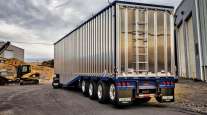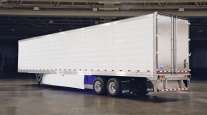Senior Reporter
July Trailer Orders Increase 41%; Industry Optimistic for 2018

U.S. trailer orders jumped 41% in July compared with the weak 2016 period, supported by demand for dry vans and flatbeds — and trailer makers said they expected similar conditions in 2018.
Preliminary net orders in July reached 14,450 units, up from 10,147 a year earlier, according to ACT Research Co.
July is typically the weakest month for orders as “fleets pause to reassess their equipment needs for the remainder of the year,” said Frank Maly, ACT’s director of commercial vehicle transportation analysis and research.
July’s final volume will be available later in August. June’s order total was 20,375, according to ACT.
“The 30% decline from June is directionally correct, but a bit more than we might have expected,” Maly said. However, cancellations remain low. “Fleets are obviously standing firm with their order commitments, an indication of fleet confidence in the near-to-medium term outlook.”
The industry year-to-date booked more than 153,000 net orders and fleet confidence coincided with last fall’s election and is “obviously ongoing,” according to ACT.
Research company FTR pegged the orders at 13,400.
In the meantime, some said signs of a pre-buy in some trailer models are emerging.
“We see a steady market for dry vans going into 2018, but a slightly less robust overall reefer market,” said David Gilliland, vice president of national accounts at Great Dane.
Gilliland said Great Dane is seeing “some pre-buy of dry vans prior to greenhouse gas Phase 2 rules becoming effective in January.”
Don Ake, FTR’s vice president of commercial vehicles, agreed with the idea of a pre-buy.
“I would say that that’s true. The [trailer order] numbers are higher than they should be,” Ake said.
In addition, build rates did not decline as much as expected, he said.
“We are running at a higher-than-normal demand rate. In just a plain year, builds would have gone down in July,” Ake said.
Taking the opposite view was Charles Willmott, chief sales officer, Strick Group.
“In trailers at least, I don’t see any electronic logging device [rule], GHG2 or other regulatory effect that is making a big difference in carrier buying patterns,” he said.
Meanwhile, customers at Stoughton Trailer are buying equipment mostly for replacement but some growth, said David Giesen, vice president of sales.
“The strength of the economy is keeping customers positive and continuing to purchase capital equipment,” he said.
ACT Research reported its for-hire trucking index in July rose for the seventh consecutive month to 57.1, up 20 points from a year earlier.
Among fleet respondents, 6% reported having significant freight gains, 49% had modest increases, 19% were flat, 21% had modest decreases and the remaining 5% of carriers saw significant decreases, according to ACT.
“I think the fundamentals have been in place for some time and the wait for it to take off has been challenging for the carriers. We all hope the freight increase is finally going to show up and justify the carriers investments and planning,” said Glenn Harney, chief sales officer, Hyundai Translead.
Both refrigerated and dry vans did well in July, he said.
The leading response from carriers for the placed orders is “that [the need for] capacity is driving this push. The mandatory shift to electronic logging devices in December certainly is mentioned as a factor,” Harney said.
At Strick, all of its products did well in July — sheet and post dry vans, container chassis and specialty steel flatbeds, Willmott said.
“I don’t currently see any predictable disrupters on the horizon that would interfere with continued ordering and production in 2018 at the 2017 pace,” he said. “In fact, short of war, failure of the U.S. to lift the debt ceiling, or the possible land-fall of multiple category 5 hurricanes between now and Christmas, we see continued high levels of demand through 2018.”




